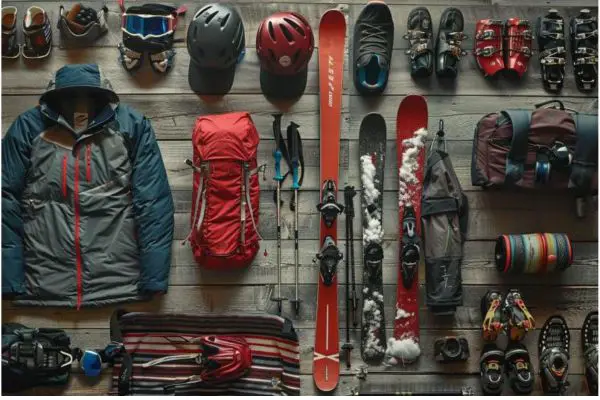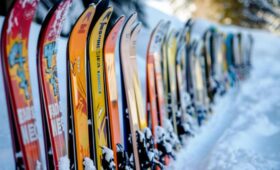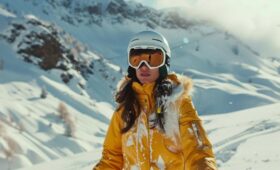
Welcome to our ultimate guide to choosing the right ski gear! Whether you’re a seasoned pro or new to the slopes, having the right equipment is essential for a safe and enjoyable skiing experience. From ski gear for sale to top-rated brands, we’ve got you covered with all the information you need to make the best choices.
When it comes to skiing, having the right ski gear is crucial for your performance and safety. From skis and bindings to boots, helmets, and accessories, each piece of equipment plays a significant role in your overall experience on the slopes. In this guide, we will take you through the essential factors to consider when selecting your ski gear, from choosing the right skis for your terrain to finding the perfect ski clothing for any weather conditions.
Key Takeaways:
- Choosing the right ski gear is crucial for a safe and enjoyable skiing experience.
- Consider factors such as terrain, skill level, and personal preferences when selecting skis, bindings, boots, and accessories.
- Renting ski gear can be a cost-effective alternative to purchasing, especially for occasional skiers or those traveling long distances.
- Layering is key when it comes to ski clothing, allowing you to adjust your attire based on weather conditions.
- Don’t forget to check off all the necessary items on your ski gear checklist before hitting the slopes.
Choosing the Right Skis
When it comes to choosing skis, it’s crucial to consider the type of terrain you’ll be skiing on. Groomed mountains, backcountry trails, and snowparks each require different types of skis. The design of the ski is also important, including factors such as rocker, camber, width, and length. These design elements should be tailored to your skill level and skiing preferences.
If you’ll be skiing on groomed mountains, you’ll want skis that are designed for speed and stability. These skis typically have a narrower width, providing better responsiveness and edge control on well-maintained slopes. On the other hand, if you’ll be venturing into the backcountry, you’ll need skis with a wider profile to provide better floatation in deep snow. These skis often feature rocker technology, which helps prevent the tips from sinking in powder.
Snowparks, with their jumps, rails, and features, require skis that are built for tricks and jumps. These skis are typically shorter and more maneuverable, allowing for quick turns and precise landings. They often have a twin-tip design, enabling you to ski forward and backward with ease.
When it comes to the design of the ski, camber and rocker are important elements to consider. Camber refers to the slight arch in the middle of the ski, which helps with edge grip and stability. Rocker, on the other hand, refers to the upward curve of the ski’s tip and tail, which aids in floatation in deep snow.
The width of the ski, also known as the waist width, is another consideration. Narrower skis (70-90mm) are more suited for groomed slopes and carving turns, while wider skis (90-110mm or more) are better for off-piste skiing and powder days.
Lastly, the length of the ski should be based on your height, weight, and skill level. For beginners, shorter skis are easier to maneuver, while advanced skiers may prefer longer skis for added stability at high speeds.
“Choosing the right skis can make all the difference in your skiing experience. Whether you’re tackling groomed runs, exploring backcountry trails, or hitting the snowpark, having the right skis for the right terrain will enhance your performance and enjoyment on the slopes.”
Remember, finding the perfect skis is a personal journey, and it’s always a good idea to seek advice from experienced skiers or reputable ski shops. They can help you find the best ski gear that meets your needs and provides the optimal combination of performance, comfort, and safety.
Next, let’s explore ski bindings and boots, two essential components of your ski gear that directly impact your safety and performance on the mountain.
Ski Bindings and Boots
When it comes to ski gear, both ski bindings and boots play a crucial role in ensuring a safe and enjoyable skiing experience. Ski bindings are responsible for connecting your boots to your skis and are designed to release in case of a crash, reducing the risk of lower leg injuries. It’s essential to choose bindings that are suitable for your skill level and skiing style.
There are two types of ski bindings: integrated bindings and separate bindings. Integrated bindings come pre-installed on skis, providing a seamless connection between your boots and skis. They offer convenience and are suitable for most recreational skiers. On the other hand, separate bindings can be chosen and installed separately, allowing for a more personalized setup. These bindings offer adjustability and customization options, making them a popular choice for advanced and expert skiers who require specific performance characteristics.
Next, let’s talk about ski boots. Ski boots are a crucial piece of ski equipment that directly affects your performance on the slopes. When selecting ski boots, one important factor to consider is the flex index. The flex index indicates the stiffness and responsiveness of the boot, with higher numbers representing stiffer boots suited for advanced skiers seeking enhanced control and power transfer.
It’s important to find the right balance between comfort and performance when choosing ski boots. Ill-fitting boots can lead to discomfort, pain, and even injury on the mountain. It’s recommended to try on multiple pairs and consult with a professional boot fitter to ensure the boots provide a snug fit without causing excessive pressure points.
Remember, ski bindings and boots are integral components of your ski gear setup. Investing in high-quality bindings and boots that are suited to your skill level and skiing style will greatly enhance your performance and overall enjoyment on the slopes.
Ski Poles and Accessories
While ski poles may not be necessary for beginners, they can be valuable tools for maintaining balance and making quick turns on the slopes. When selecting ski poles, it’s important to consider factors such as length and weight that are suitable for your height and skiing style. Opt for poles that provide the right amount of support and control, allowing you to navigate the terrain with ease.
Goggles and helmets are essential accessories for any skier, offering protection for your eyes and head. When choosing goggles, consider factors such as lens type, fit, and compatibility with your helmet. Look for goggles that provide clear vision, prevent fogging, and offer UV protection. Helmets, on the other hand, should be comfortable, well-fitted, and meet safety standards.
Remember to invest in top-rated ski gear, including accessories, to ensure both safety and performance on the slopes. The right ski poles, goggles, and helmet can enhance your skiing experience, providing added support and protection as you carve through the snow.
Protect Your Eyes with Quality Goggles
Protecting your eyes while skiing is crucial for a safe and enjoyable experience. Goggles not only shield your eyes from the sun, wind, and snow, but they also improve visibility and prevent glare on the slopes. Look for goggles with a wide field of vision, anti-fog technology, and adjustable straps for a secure fit. Consider lens color options that are suitable for different light conditions, such as mirrored lenses for bright sunny days and low-light lenses for overcast conditions.
Stay Safe with a Reliable Helmet
A helmet is an essential piece of ski gear that protects your head from potential injuries while skiing. Look for helmets that meet safety standards and provide a snug fit without being too tight. Adjustable vents and padding for comfort are also important features to consider. Remember to choose a helmet that is compatible with your goggles to ensure a proper fit and optimal protection.
Ski Clothing
When hitting the slopes, having the right ski clothing is essential for both comfort and performance. The right gear can make a significant difference in your skiing experience, keeping you warm, dry, and protected from the elements. Here are some key factors to consider when selecting ski clothing:
Layering for Warmth and Comfort
Layering is crucial in ski clothing to adapt to changing weather conditions and regulate body temperature. Start with a thermal base layer that wicks away moisture from the skin, keeping you dry and warm. Fleece or mid-layer jackets provide insulation for extra warmth, and they can be easily added or removed as needed. Top it off with a waterproof and breathable outer layer to protect against wind, snow, and rain.
Waterproof Jackets and Pants
Waterproof jackets and pants are a must-have for any skier. Look for ski gear with advanced waterproofing technologies such as Gore-Tex or DWR (Durable Water Repellent) coatings. These materials keep you dry by preventing water from seeping through the fabric while allowing moisture to escape, ensuring breathability.
Insulated Pants for Extra Warmth
In colder conditions, insulated ski pants provide an additional layer of warmth. Look for pants with synthetic or down insulation to trap heat and keep your legs cozy. Adjustable waistbands and suspenders can help customize the fit for added comfort.
Tall Socks and Properly Fitting Ski Boots
Choosing the right socks and ski boots is essential for comfort and performance. Opt for tall socks that are specifically designed for skiing to keep your feet warm and protected. Additionally, ensure that your ski boots fit properly. Ill-fitting boots can lead to discomfort and hinder your ability to control your skis effectively.
By selecting ski clothing that suits your needs and preferences, you can enjoy your time on the slopes while staying warm, dry, and comfortable in any weather conditions.
Cost of Ski Gear
Ski gear can be expensive, with skis alone costing several hundred dollars.
In addition to skis, bindings, boots, and accessories, the cost of packing and traveling with your gear can add up.
An alternative to purchasing ski gear is renting, which allows you to have high-quality equipment delivered and fitted to your specifications.
This can be a cost-effective option for both individuals and families.
If you’re looking for ski gear for sale, there are various online retailers and local ski shops that offer competitive prices and discounts on top-rated ski gear.
By comparing prices and considering the quality, durability, and features of different brands, you can find the best ski gear at affordable prices.
When renting ski gear, make sure to book in advance to secure availability and ensure a proper fit.
Now let’s take a look at some of the top-rated ski gear brands and their offerings.
Top-rated Ski Gear Brands
“Our gear is tested and trusted by professional skiers around the world. We provide the best ski gear for all skill levels.”
– Alpina Ski Equipment
“We offer a wide range of affordable ski gear without compromising on quality and performance. Our gear is designed to enhance your skiing experience.”
– Atomic Ski Equipment
“Our ski gear is known for its durability, functionality, and style. We prioritize customer satisfaction and aim to provide the best value for your money.”
– Rossignol Ski Equipment
As you can see, there are plenty of options available when it comes to ski gear.
Whether you choose to purchase or rent, make sure to consider your budget, preferences, and specific needs when selecting the best ski gear for your skiing adventures.
By doing so, you can enjoy the slopes with confidence, knowing that you have the right equipment to enhance your skiing experience.
Ski Gear Checklist
Before hitting the slopes, it’s essential to have all the necessary ski gear. Ensuring you have all the right gear will contribute to a safe and enjoyable skiing experience. Here’s a comprehensive checklist of the ski gear you’ll need:
Helmets
Keyword: ski gear
A helmet is a must-have item for skiing. It provides crucial protection for your head, minimizing the risk of serious injury in case of falls or collisions.
Goggles
Keyword: ski equipment
Goggles protect your eyes from wind, snow, and harmful UV rays. They also enhance visibility on the slopes, allowing you to ski with confidence.
Layers
Keyword: skiing accessories
Layering your clothing is important to regulate body temperature while skiing. Start with a moisture-wicking base layer, add insulating mid-layers, and top it off with a waterproof and breathable outer layer.
Jackets
Keyword: best ski gear
A high-quality ski jacket is essential to keep you warm, dry, and protected from the elements. Look for jackets with insulation, waterproofing, and ventilation features for optimal comfort.
Gloves
Keyword: affordable ski gear
Invest in a pair of waterproof and insulated gloves to keep your hands warm and protected from the cold and wet snow. Look for gloves specifically designed for skiing to ensure optimal dexterity and grip.
Poles
Keyword: top-rated ski gear
Ski poles help with stability, balance, and maneuverability on the slopes. Choose poles that are the correct length for your height and skiing style.
Snow Pants
Keyword: ski clothing
Invest in a pair of waterproof and insulated snow pants to keep your legs warm and dry. Look for pants with reinforced knees and seat for added durability.
Socks
Keyword: ski gear
Wearing proper ski socks is important for comfort and performance. Choose socks made specifically for skiing, as they provide cushioning, moisture-wicking, and thermal properties.
Ski Boots
Keyword: ski equipment
Ski boots are a critical part of your ski gear. They should fit properly and provide sufficient support and control. Consider getting your boots professionally fitted for optimal performance.
Skis and Bindings
Keyword: best ski gear
Choosing the right skis and bindings is essential for your skiing experience. Consider factors such as ski length, width, and flex, as well as bindings that are suitable for your skill level and skiing style.
Conclusion
Choosing the right ski gear is essential for a successful and enjoyable skiing experience. Whether you’re hitting the groomed slopes, exploring the backcountry, or shredding in the snowpark, having the appropriate ski equipment can make all the difference. Consider factors such as the terrain you’ll be skiing on, your skill level, and your personal preferences when selecting skis, bindings, boots, and accessories.
While purchasing ski gear can be an investment, it’s important to remember that quality gear is worth it in the long run. Look for the best ski gear that offers durability, performance, and comfort. However, if you’re on a budget or trying skiing for the first time, renting ski gear can be a cost-effective alternative. Many reputable companies offer top-rated ski equipment for rent, allowing you to enjoy the slopes without breaking the bank.
Before heading out to the mountains, make sure you have all the necessary items. Create a comprehensive checklist of ski gear, including helmets, goggles, layers, jackets, gloves, poles, snow pants, socks, ski boots, skis, and bindings. Having all the right gear will not only keep you safe but also enhance your skiing experience.
So, whether you’re a seasoned pro or a beginner, choosing the best ski gear that suits your needs is key to a successful and thrilling time on the slopes. Consider your options, plan ahead, and get ready to hit the snow with confidence!


